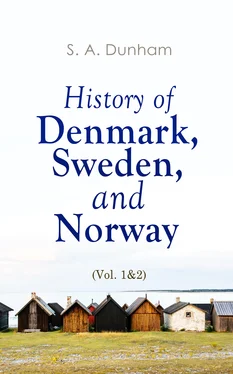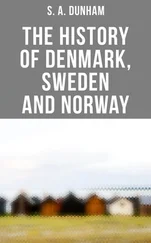S. A. Dunham - History of Denmark, Sweden, and Norway (Vol. 1&2)
Здесь есть возможность читать онлайн «S. A. Dunham - History of Denmark, Sweden, and Norway (Vol. 1&2)» — ознакомительный отрывок электронной книги совершенно бесплатно, а после прочтения отрывка купить полную версию. В некоторых случаях можно слушать аудио, скачать через торрент в формате fb2 и присутствует краткое содержание. Жанр: unrecognised, на английском языке. Описание произведения, (предисловие) а так же отзывы посетителей доступны на портале библиотеки ЛибКат.
- Название:History of Denmark, Sweden, and Norway (Vol. 1&2)
- Автор:
- Жанр:
- Год:неизвестен
- ISBN:нет данных
- Рейтинг книги:5 / 5. Голосов: 1
-
Избранное:Добавить в избранное
- Отзывы:
-
Ваша оценка:
- 100
- 1
- 2
- 3
- 4
- 5
History of Denmark, Sweden, and Norway (Vol. 1&2): краткое содержание, описание и аннотация
Предлагаем к чтению аннотацию, описание, краткое содержание или предисловие (зависит от того, что написал сам автор книги «History of Denmark, Sweden, and Norway (Vol. 1&2)»). Если вы не нашли необходимую информацию о книге — напишите в комментариях, мы постараемся отыскать её.
The Pagan Age:
Denmark (B.C. 40 to A.D. 1014)
Sweden (A.C. 70 to A.D. 1001)
Norway (about A.C. 70 to A.D. 1030)
Maritime Expeditions of the Northmen During the Pagan Times:
In England, France, and Ireland
Maritime Expeditions of the Northmen During the Pagan Times:
In the Orkneys, the Hebrides, Iceland, Greenland, North America, Russia, etc.
Cosmogony and Religion of Scandinavia
Introduction of Christianity Into Denmark and Sweden
The Middle Age:
Denmark (1014-1387)
Norway (1030-1387)
Sweden (1001-1389)
History of Denmark, Sweden, and Norway (Vol. 1&2) — читать онлайн ознакомительный отрывок
Ниже представлен текст книги, разбитый по страницам. Система сохранения места последней прочитанной страницы, позволяет с удобством читать онлайн бесплатно книгу «History of Denmark, Sweden, and Norway (Vol. 1&2)», без необходимости каждый раз заново искать на чём Вы остановились. Поставьте закладку, и сможете в любой момент перейти на страницу, на которой закончили чтение.
Интервал:
Закладка:
|623 to 630.|
By the death of Ingiald, his son, Olaf Trætelia , was the last of the Ynglings; but his claim to the throne, however sanctioned by custom or blood, was not likely to avail in opposition to so powerful an enemy as Ivar Vidfadme. At this moment, Ivar was at the head of the Danish, the Swedish, part of the Saxon and Anglian states (the Angles of Holstein); and his career was not to be resisted by a youth without army, without followers. Indeed, Olaf made no effort to resist; he saw that the people were resolved on the expulsion of the Ynglings; and, with the few friends who adhered to him, he hastened to the desert lands north and west of the Vener Lake. There he cleared off the forests—hence his surname of Trætelia, or the Tree-feller—drained them, and not only rendered them habitable, but in a short time made them the foundation of a new state, that of Vermeland. From him descended the famous Harald Harfager, monarch of Norway, the restorer of the ancient glory of the Ynglings. [134]
The crimes and misfortunes of this dynasty must, to every reader, contrast strangely with its pretended divine origin. Compared to it, the fate of our Stuarts was a happy one. If we except the companions of Odin, the ends of most were tragical. Fiolner was drowned in a butt of mead; Swegdir, whatever the manner of his death, did not leave this world in a natural way; Vanland perished, not by the hands of witches, but those of conspirators; Visbur was burnt to death by his own sons; Domald was sacrificed on Odin’s altar by his subjects; Dag was killed by a slave; Agne was hung by his bride; Alaric and Eric were killed by each other’s hands, or by conspirators; Alf and Yngve certainly slew each other; Hugleik was slain by Hako or Sterkodder; Eric died in battle; Jorund was ignominiously hung; Egil was gored to death by a wild bull; Ottar was killed by the Danes; Adils by the fall of his horse; Eystein perished by the hands of pirates; Ingvar by those of the Esthonians; Braut-Onund by an avalanche; Ingiald Illrada was forced to destroy himself; and Olaf Trætelia was driven into everlasting exile. Thus, out of twenty-two sovereigns, from Fiolner to Olaf, three only died a natural death; for that of Olaf, as we shall soon perceive, was also tragical. Assuredly there was nothing in the pre-eminence, divine as it was, of the Ynglings, to render it an object of envy, either to their own times or to posterity. [135]
The fortunes of Olaf Trætelia and of his successors may be found in the chapter devoted to the early Norwegian history. Henceforth Sweden, or to speak more precisely, the Swedes, are under the sceptre of the Skioldungs, and not of the Ynglings, though the former, like the latter, were of Odin’s race, being descended from Skiold, whose seat was established at Ledra in Zealand. They did not exercise the sacerdotal functions; they were not pontiff kings; consequently, they were not held in the same veneration as those who were privileged to officiate at Odin’s altar.—Before we proceed with this Swedish branch of the Skioldungian dynasty, we must revert to the Gothic dynasty established in another part of Sweden. At every step we take in the history of this obscure period, we are more fully convinced that the hypothesis we have framed is based on truth; viz., that while the Swiones or Swedes were located in the provinces bordering on Upsal, and were governed by their own kings, the Goths were in the more southern and western provinces, with a dynasty of their own. Where was the seat of this latter dynasty? Probably it was not always stationary. It appears to have been sometimes in West, sometimes in East, Gothland; just as those provinces obeyed one or two kings. Scania too, which, politically, was a province of Denmark, yet geographically a portion of Sweden, was inhabited by Goths, the seat of whose government was Lund. As the kings of Scania, or of East and West Gothia, obtained the preponderance, they were called kings of the Goths. In the same measure, when the Danish star was triumphant, Ledra, or Odensee, or Lund, or some town of Jutland, was regarded as the metropolis of the Goths. But in each of the Gothic provinces of Sweden there was a resident court, and consequently a capital, whose ruler was sometimes dependent on the king of Scania, sometimes on him of Upsal, but more frequently, perhaps, independent of them all. However this be, it is certain that the kings of all these provinces, except Jutland, have been confounded. Hence the uncertainty of regal lists, and, in many instances, their contradiction to one another. In general, the prince who happened to have the preponderance for the moment, whether his seat was in the Gothlands or in Scania, was called king of the Goths. All were, or professed to be, equally descended from Odin; nor is this improbable, when we perceive how frequently a conqueror divided, at his death, his dominions among his sons. This fatal example, as we have seen, was set by Odin himself. Over Scania he placed his son Heimdal; over Zealand and the surrounding islands, his son Skiold; over Jutland and Holstein, his son Balder; over the Swedes at Upsal, his kinsman Freyr; and over the Norwegians, as we shall soon perceive, his son Semming. Such, at least, is the consistent voice of tradition, as perpetuated in the oldest records now extant. [136]
From the preceding observations, and from many others in this and the last chapter, the reader will be prepared for the amazing variations in the chronological lists of northern kings, as given by Saxo, Snorro Sturleson, and Joannes Magnus. Thus the king of Scania was sometimes the chief of all the Danes, sometimes of all the Goths, sometimes of both; but in general the kings of the two Gothlands were the acknowledged heads of their nation, whether they happened to be independent, or politically subject to the Danes on the one side, or the Swedes on the other. Besides, the intermarriages which constantly took place among these sovereigns would make them, eventually, of one great family, even if most of them had not derived their origin from the warrior god of the north. Still there were kings who had no such boast, who descended from a regal stem more ancient than theirs, whose ancestors were rulers in the Gothic provinces of Sweden, centuries, perhaps, before Odin was born. And for anything we can prove to the contrary, there might, in the interior of Sweden, be reguli who descended from the original, almost indigenous rulers—from the old Finnish stock; for though the Goths, who were there before the arrival of the kindred tribe of the Swiones, were the dominant caste, they would govern the inland provinces through native chiefs. At this distance of time, however, it is impossible to distinguish the two; nor is it often possible to distinguish the earlier from the subsequent Gothic princes—those who sprung from ancestors prior to Odin’s arrival, from those who descended from the Swionian branch. [137]
According to the Heimskringla, the oldest and best authority for Swedish history, when Odin arrived in the north he found a monarch named Gylfo in possession of the supreme power. [138]Was this Gylfo of the Gothic or of the anterior race? This question cannot be answered. From one circumstance, viz., his alleged proficiency in magic science, we should infer that he was a Finn, were it not doubtful whether the Goths did not also cultivate this pretended science, and whether, from the facility of his intercourse with Odin, and from the locality which he occupied, he was not of a race kindred with that of the Swiones—one that had immigrated into these regions from Asiatic Scythia centuries, perhaps, before “this king of the Turks.” Gylfo is said to have ceded to the strangers a portion of his territory, and that they settled to the north of him. This statement, again, confirms the inference of his Gothic descent. However, from that day down to the permanent union of the two nations—the Goths and the Swedes—under one head (temporary unions had been frequently effected), the more southern people had their own king, their own government and laws. By what degrees the Swiar obtained the ascendancy over the Goths may be easily conjectured. The latter were, at an early period, induced to embrace the religion of the former, or, we should rather say, a modification of that religion; for that they, like the Norwegians, combined a few more ancient tenets with the faith of Odin, may be inferred from many passages. And with all due allowance for this circumstance, we cannot but feel surprise at the facility with which both Norwegians and Goths were brought to the temples of the new faith. This could scarcely be the result of force, since the Swiar do not appear to have been very numerous in comparison with the rest of the population. Like the Saxons in England; and the Scots in Ireland, and the Mohammedans in India, they were the dominant caste, and no doubt their individual valour was superior to that of the natives. Still, in the earliest Norwegian and Danish accounts of these remote transactions, we do not read of the physical so much as of the moral influence of Odin and his immediate successors. They might be numerous enough to obtain possession of any neighbouring province, or even to defeat the petty chiefs with which the country swarmed; but they would scarcely be sufficient to make both Goths and Norwegians embrace a new faith. Between temporal and religious domination there is a wide difference; and all history proves that men will fight more willingly, more perseveringly, for speculative opinions, than for the most substantial social advantages. The comparative ease with which Odin, or rather his immediate successors, thus forced the positive or modified observance of their religious system on a great population, has led some northern writers to assume that before his arrival another Odin had been there, the apostle of a kindred faith. [139]But this assumption is gratuitous; we have no good reason for it; and even if we had, the question would still occur, “By what means did this former prophet procure the ascendancy of his religion?” There is but one mode of solving this difficulty, and this is hypothetical. Probably, as both Goths and Swedes—perhaps, too, a considerable portion of the older race—had come from the same Asiatic Scythia, there was between some of their religious opinions an affinity, if not an identity; and this affinity would naturally facilitate the progress of the new faith. If to this consideration we add the pomp with which the sacrifices were conducted—the splendour of the temple—the crowd of officiating priests, with the king at their head—the imposing solemnity of the scene—the alleged godlike descent of the pontiff chief—the reputation which all the Asser priests enjoyed for supernatural knowledge—we shall scarcely be surprised at the rapid progress of the Odinic worship. As a prophet, too, especially one so highly descended, Odin must have pretended to the gift of miracles, or, what is the same thing, to the power of effecting wonderful results by his knowledge of nature’s mysteries. This combination of circumstances must have imposed on the Goths, as on the Norwegian and other ancient tribes. It may account for the facility with which both nations embraced the new faith, and ultimately acknowledged even the temporal superiority of the Swiar. It is certain that as early as even the time of Tacitus, the latter were the dominant tribe; yet, as they occupied the sea-coast—the usual locality of the last comers—we may doubt whether they had been there above two centuries. But this superiority being of a moral, not of a physical nature, was often resisted by the Gothic kings, who did not hesitate to march on Upsal, to put the half divine pontiff to death, and to ascend his throne. [140]
Читать дальшеИнтервал:
Закладка:
Похожие книги на «History of Denmark, Sweden, and Norway (Vol. 1&2)»
Представляем Вашему вниманию похожие книги на «History of Denmark, Sweden, and Norway (Vol. 1&2)» списком для выбора. Мы отобрали схожую по названию и смыслу литературу в надежде предоставить читателям больше вариантов отыскать новые, интересные, ещё непрочитанные произведения.
Обсуждение, отзывы о книге «History of Denmark, Sweden, and Norway (Vol. 1&2)» и просто собственные мнения читателей. Оставьте ваши комментарии, напишите, что Вы думаете о произведении, его смысле или главных героях. Укажите что конкретно понравилось, а что нет, и почему Вы так считаете.












